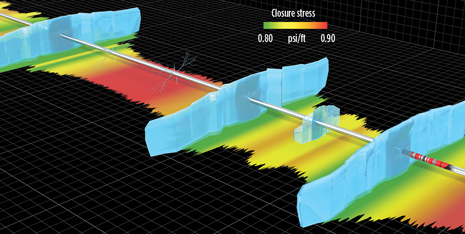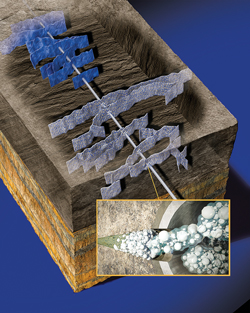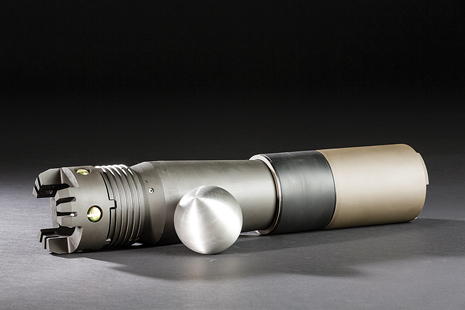Although hydraulic fracturing of reservoirs has been around for over 60 years, recent fracturing advances in association with horizontal drilling and other techniques, have placed a whole new emphasis on further development. The technology isn’t new, but it is still evolving.
For example, the most common method of zonal isolation used in today’s multi-stage fracturing treatments is known as plug-and-perf. In this method, multiple perforation clusters are shot for each stage, and each stage is isolated, using a frac plug placed by wireline pump-down operations. This method has been shown to be effective at isolating stages and, therefore, is being used for 75% to 85% of all multi-stage treatments.
One challenge that has arisen for plug-and-perf completions—and that has been demonstrated with modeling, production logging and microseismic mapping studies—is that most multi-zone fracturing techniques do not distribute proppant evenly across the multiple perforation clusters, leaving much of the pay zone unstimulated. The poorly stimulated or missed clusters create gaps in the fracture network and have a major economic impact on the well’s profitability by hindering production flowrates and reducing the well’s estimated ultimate recovery (EUR).
Halliburton has addressed this challenge of multi-cluster stimulation with a strategy to maximize the number of perforation clusters that receive stimulation, by sequentially stimulating each zone through a series of treatments separated by a customizable diversion spacer. This technique is also known as an intrastage diversion. Using diverting agents in oil and gas wells has been around for many years, but only recently, a new generation of biodegradable, high-performance-sealing, self-removing, multi-modal chemical diverting agents has proven efficient and effective. New precision delivery methods have also made it possible to achieve on-demand, competent diversion efficiency in even the most difficult applications.
The new technology allows the industry to execute advanced design techniques to deliver a more effective hydraulic fracturing system during primary completions of horizontal multi-cluster wells. These precision applications include sequential stimulation of each zone in a completion, to improve cluster efficiency. That is, a series of proppant cycles or treatments is pumped on each interval, with each cycle separated by a diversion spacer. An additional application enables effective re-fracturing of horizontal multi-cluster wells in source rock reservoirs (SRRs), most commonly termed shale formations, without using any mechanical isolation methods.
INTRASTAGE DIVERSION METHOD
Many of today’s wells are designed with tight perforation cluster spacing to increase the number of fractures contacting the formation and intersecting the wellbore. This strategy is based on reservoir simulation and production correlation to optimize overall reservoir drainage volume per wellbore. These progressive reservoir-specific designs present a high degree of difficulty to stimulate effectively; that is, to initiate and propagate a unique fracture from each of the designed perforation clusters.
The difficulty in simultaneously initiating multiple dominant fractures in close proximity to each other is an agreed-upon concept in the industry. This finding is reinforced by treatment, production, diagnostic sensor and geomechanical modeling data. The effect can be explained by interference between fractures propagating from closely spaced clusters, essentially acting as competing fractures and, to the natural high degree of heterogeneity in formation closure stress, the designed clusters penetrate along each stage of the lateral.
These wells typically include multiple clusters per stage interval (3 to 6), with tight spacing or a high cluster density, and can include 15 to 30 isolated zones. To sequentially stimulate each zone, using an intrastage diversion, presents a very small margin for error in diversion efficiency from a design and operational delivery standpoint.
The solution developed by Halliburton is the AccessFrac intrastage diversion system, Fig. 1. This system, Halliburton says, enables a higher cluster efficiency to be achieved on each zone. The method works by separating the stimulation of the initially dominant clusters from clusters that are non-dominant on the initial injection, due to intersecting portions of the rock with a higher closer stress. In addition to stress contrast between clusters, a portion of the clusters in an interval can encounter fracture-to-fracture interference, called stress shadowing, that tends to pinch the near-wellbore region contacted by inner clusters, and limit fracture propagation from them.
 |
| Fig. 1. Heterogeneous rock properties and formation closure stresses between perforation clusters can affect where the fractures initiate and grow (image courtesy of Haliburton). |
|
The perforation clusters that break down initially and take fluid will typically be those that intersect the lowest formation closure stress in the interval. A higher bottomhole pressure is required to break down the clusters shot in the higher stress regions. Using this sequential method, after the first proppant cycle is placed, a diversion spacer is designed to be pumped into the wellbore to bridge and seal the initially dominant clusters. This process results in an elevated BHP. This higher pressure allows the breakdown of subsequent clusters in the higher closure stress areas and can overcome the stress shadow placed in the interval by the first treatment cycle.
The fracturing fluids pumped on the second cycle are placed into the newly broken-down perforation clusters. The end result, the company says, is more effective stimulation of each designed perforation cluster, and a higher cluster efficiency that is demonstrating enhanced production results over conventional stimulation methods.
EAGLE FORD CASE HISTORY
Halliburton reports that earlier this year, an Eagle Ford shale operator completed its first trial well of the AccessFrac intrastage diversion application, to improve perforation cluster completion efficiency on each zone. Each of the 18 stages consisted of a series of two equally sized treatments, with a diversion spacer separating them. Each zone was 220 ft plug-to-plug, and had six perforation clusters spaced 33 ft apart. The two deepest were 2 ft, and the remaining four were 1 ft each, all having a shot density of 6-SPF.
The trial well was part of a four-well pad; each well received equal proppant amounts and had an equal number of stage intervals. The initial flow tests, Halliburton reports, showed the trial well outperforming the average of the three offsets by 19% for oil production and 39% for gas output.
After 60 days of production, the AccessFrac well in the trial had produced 17% more (boe) than the best of the three same pad offsets, and was predicted to have a 25% higher EUR of oil over its life than the other three, which all came in relatively the same, according to Halliburton. Since the first trial well, the intrastage diversion system has been applied to 10 subsequent wells, representing over 220 successful stage applications, with minimal adverse impact on the completion design or efficiency, the company says.
In the end, Halliburton says, better stimulation coverage is being achieved along the lateral, due to a higher percentage of the perforation clusters receiving stimulation, and this is leading to consistently improved production volumes. Halliburton reports that the intrastage diversion method enables sequential stimulation of each zone, allowing the treatment to overcome differences in formation stresses, and the natural cluster interference or pinching that occurs while pumping into multiple clusters.
BROADBAND SEQUENCING
In another advance in fracturing technology, Schlumberger has introduced its BroadBand Sequencing technology, which the company says enables sequential stimulation of perforation clusters in wells drilled in unconventional reservoirs. The new technique sequentially isolates fractures at the wellbore, to ensure that every cluster in each zone is fractured.
According to Schlumberger, the technique results in greater production and completion efficiency, compared to conventional methods. Developed using a composite fluid comprising a proprietary blend of degradable fibers and multimodal particles, the BroadBand Sequence technique is designed for use in new wells and in recompletions. Schlumberger says the technique is particularly suitable for re-fracturing operations, given its ability to promote temporary cluster isolation without the aid of mechanical devices, such as bridge plugs, Fig. 2.
 |
| Fig. 2. The BroadBand technique developed by Schlumberger is designed for re-fracturing operations, given its ability to promote temporary cluster isolation without the aid of mechanical devices, such as bridge plugs. |
|
“Optimizing the stimulation of wellbore perforation clusters in unconventional reservoirs is a significant challenge for our industry,” said Amerino Gatti, president, Well Services, Schlumberger. “The BroadBand Sequence technique addresses this challenge and increases our customers’ well production by enhancing stimulation contact in every zone in the reservoir.” Schlumberger says the technique has delivered robust, consistent performance in more than 500 operations in several unconventional plays, including the Eagle Ford, Haynesville, Woodford, Spraberry and Bakken shales.
According to Schlumberger, the technique has enabled customers in South Texas to increase production from new completions in unconventional reservoirs by more than 20%, and has reduced well completion time by up to 46% in plug-and-perf operations. This was accomplished by stimulating longer intervals, compared with conventional methods. The technology was applied to a well in South Texas for a re-fracturing operation that resulted in double the production, with a four-fold increase in flowing pressure, the company said.
BroadBand Sequence is the first release of a family of completion technologies aimed at maximizing well productivity in unconventional reservoirs. Schlumberger cites the case of an independent operator in the Eagle Ford that focuses on the optimization of field development operations, with the goal of finding the most effective, efficient methods to complete wells. The operator typically uses the plug-and-perf technique, Schlumberger says, with the following parameters per stimulation stage: an interval length of 200 ft and four perforation clusters.
The interval length dictates the required number of plug-setting operations along the wellbore, and therefore completion times, as well as operational costs. Extending the interval length without altering the spacing between perforation clusters would provide a solution to reduce time and cost. However, limitations on treating rate and fracture gradient anisotropy could lead to ineffective fracturing-fluid distribution among the increased number of clusters within the interval, potentially compromising well productivity and EUR. An effective stimulation technique that would optimize fluid and proppant allocation was required.
The BroadBand Sequence fracturing technique was used in one well to evaluate its ability to address the challenge. For the candidate well, the interval length was tripled to 600 ft, greatly reducing the total number of bridge plugs required. The number of perforation clusters per interval was also tripled (to 12) by keeping the spacing between clusters unchanged. For a fair test, the amount of proppant per unit length of lateral and the pumping rate were also kept the same, as for a conventional completion. Three stimulation stages were used per interval, separated by two pills of composite fluid.
Schlumberger reports that the BroadBand Sequence technique saved time and cost without lowering productivity. Eight intervals were stimulated, separated by seven bridge plugs. The eighth interval was 400 ft long and, therefore, needed only two stages of proppant (separated by one pill of the BroadBand technique composite fluid), resulting in 23 stages in all. The total operating time for stimulation, milling out the plugs via CT, and subsequent cleanout was 56 hr. An equivalent 23-stage operation using the conventional completion technique would have required 22 bridge plugs and 104 hr.
The effectiveness of the BroadBand Sequence technique was confirmed through surface pressure responses and tracer logs, Schlumberger says. Based on 60 days of oil-, water-, and gas-rate measurements, production from the candidate well was on par with a comparable offset well completed conventionally. The BroadBand Sequence technique provided 46% savings in completion time and 68% savings in plug costs, helping the operator achieve a higher rate of return, Schlumberger says.
SHADOW FRAC PLUG
Baker Hughes, meanwhile, has introduced its Shadow series frac plug, (Fig. 3), a permanent millable plug designed to be left downhole during production—a capability that the company says eliminates the plug drill-out phase of plug-and-perf completions. The plug features a large flow-through inner diameter (ID) and uses the company’s disintegrating frac balls, so that production can flow with the plugs in place. The plugs cut days off of completion times, Baker Hughes says, and eliminate the cost and risk associated with coiled tubing (CT) intervention.
 |
| Fig. 3. Baker Hughes’ Shadow frac plug can be left downhole during production, which eliminates the plug drill-out phase of plug-and-perf completions. |
|
The frac plugs are run in-hole on wireline and are set in sequence along the lateral section of the wellbore to isolate zones for treatment, just like composite plugs. The initial reservoir entry point is created using Baker Hughes’ own sleeve pressure-actuated valve, rather than a perforating gun run in on CT. After all zones have been perforated and fractured, the plugs stay in the well, and production can be turned on without intervention, and with no reduction in production volume.
The Baker Hughes IN-Tallic disintegrating frac balls are made of controlled electrolytic metallic (CEM) nano-constructed material—a technology pioneered by Baker Hughes. The balls hold pressure during fracturing operations, and then completely disintegrate in the well when exposed to produced fluids, preventing production blockages and eliminating debris.
Baker Hughes cites a field application in which an operator in the Horn River basin of northern British Columbia wanted to significantly improve overall well site efficiency and reduce time on location during plug-and-perf hydraulic fracturing operations. The operator had a seven-well pad and agreed to complete two of the wells with Shadow frac plugs. The other five wells were completed with conventional composite plugs. Baker Hughes set 27 Shadow plugs in the first well and 25 in the second. Because of the plugs’ large ID, the wells were ready to be put on production, as soon as fracturing operations were complete, the company says. 
|





